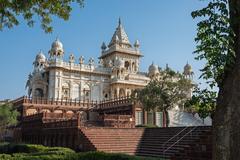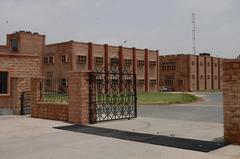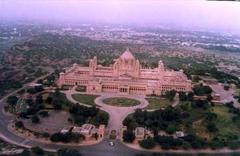Visiting Mehrangarh: History, Tickets, and Travel Tips
Date: 16/07/2024
Discover the Majestic Mehrangarh Fort in Jodhpur
Mehrangarh Fort, perched majestically on a rocky hill in Jodhpur, Rajasthan, is one of India’s largest and most magnificent forts. Built in 1459 by Rao Jodha, the fort stands as a testament to the architectural prowess, cultural richness, and strategic acumen of the Rajput era (Mehrangarh Museum Trust). With its massive fortifications, grand palaces, and intricate carvings, Mehrangarh Fort offers visitors a fascinating journey through centuries of history. This guide delves into the fort’s rich historical background, architectural brilliance, and cultural significance while providing practical information for travelers, such as visiting hours, ticket prices, travel tips, and nearby attractions. Whether you’re a history buff, a culture enthusiast, or a curious traveler, Mehrangarh Fort promises an unforgettable experience (Rajasthan Tourism).
Table of Contents
- Introduction
- The History of Mehrangarh
- Cultural Significance
- Visitor Information
- Special Events
- Restoration and Preservation
- FAQ
- Conclusion
Exploring Mehrangarh Fort
Introduction
Mehrangarh Fort, one of India’s largest and most magnificent forts, is a testament to the rich history and culture of Rajasthan’s Marwar region. This article delves into the fort’s fascinating history, architectural evolution, and cultural significance. Additionally, it provides practical information for visitors, including visiting hours, ticket prices, travel tips, and nearby attractions.
The History of Mehrangarh
Foundation and Early History
Mehrangarh Fort was founded by Rao Jodha in 1459. Rao Jodha, the fifteenth ruler of the Rathore dynasty, strategically built the fort on a rocky hill known as Bhakurcheeria, or the Mountain of Birds, to offer a strong defensive position. The construction of the fort marked the establishment of Jodhpur as a significant city in the region (Mehrangarh Museum Trust).
Architectural Evolution
The fort’s architecture showcases various periods of its construction over five centuries, blending Rajput, Mughal, and European styles. Notable structures include the Moti Mahal (Pearl Palace), Phool Mahal (Flower Palace), and Sheesh Mahal (Mirror Palace), each featuring intricate carvings and elaborate decorations (Rajasthan Tourism).
Strategic Importance
Mehrangarh Fort’s location and formidable construction made it a critical military stronghold. Its walls, rising up to 36 meters and 21 meters wide, provided robust defense against invaders. The fort played a significant role in various historical conflicts, including battles against the Mughals. Gates like Jai Pol (Victory Gate) and Fateh Pol (Victory Gate) commemorate significant victories (India Today).
The Rathore Dynasty and Mughal Relations
The Rathore dynasty’s relationship with the Mughal Empire was complex, marked by both conflict and alliance. During Maharaja Jaswant Singh’s reign (1638-1678), significant developments occurred. Jaswant Singh served as a high-ranking officer in the Mughal court, earning favor from Emperor Aurangzeb. However, the fort also became a site of resistance against Mughal dominance, particularly under Maharaja Ajit Singh (Encyclopaedia Britannica).
British Colonial Period
During the British colonial period, Mehrangarh Fort remained a symbol of Rajput pride. Maharaja Takht Singh (1843-1873) and his successors maintained autonomy by aligning with the British. The fort continued to serve as a royal residence and administrative center (The Hindu).
Post-Independence Era
After India’s independence in 1947, princely states like Jodhpur were integrated into the Indian Union. Maharaja Hanwant Singh played a significant role in this process. Following his death in 1952, Maharaja Gaj Singh II transformed Mehrangarh Fort into a museum and cultural center, preserving its heritage (Mehrangarh Museum Trust).
Cultural Significance
Mehrangarh Fort is a cultural hub, housing an extensive collection of artifacts, including weapons, paintings, costumes, and manuscripts. The fort’s museum is renowned for its well-preserved exhibits, such as palanquins, howdahs, and royal cradles, reflecting the opulence of the Rajput era (Lonely Planet).
Visitor Information
Visiting Hours and Tickets
- Visiting Hours: Mehrangarh Fort is open daily from 9:00 AM to 5:00 PM.
- Tickets: Ticket prices vary for domestic and international tourists. For the latest prices, visit the official website.
Travel Tips
- Best Time to Visit: The best time to visit is between October and March when the weather is pleasant.
- Guided Tours: Guided tours are available and highly recommended for a comprehensive understanding of the fort’s history and architecture.
- Photography: The fort offers numerous photographic spots, including panoramic views of Jodhpur city.
Nearby Attractions
- Jaswant Thada: A stunning marble cenotaph located near the fort.
- Umaid Bhawan Palace: A magnificent palace and museum showcasing royal artifacts.
- Clock Tower and Sardar Market: A bustling market area offering local crafts and cuisine.
Accessibility
- Getting There: The fort is easily accessible by road. Taxis and auto-rickshaws are readily available in Jodhpur.
- Facilities: The fort provides facilities for differently-abled visitors, including ramps and accessible restrooms.
Special Events
Mehrangarh Fort hosts various cultural events, such as the Rajasthan International Folk Festival (RIFF) and the World Sacred Spirit Festival, celebrating the region’s vibrant traditions and artistic expressions (Rajasthan Tourism).
Restoration and Preservation
Efforts to restore and preserve Mehrangarh Fort have been ongoing since the mid-20th century. The Mehrangarh Museum Trust, established by Maharaja Gaj Singh II in 1972, plays a pivotal role in these efforts. Conservation projects maintain the fort’s structural integrity and aesthetic appeal, ensuring it remains a testament to the region’s rich heritage (Mehrangarh Museum Trust).
FAQ
- What are the visiting hours of Mehrangarh Fort?
- Mehrangarh Fort is open daily from 9:00 AM to 5:00 PM.
- How much do tickets to Mehrangarh Fort cost?
- Ticket prices vary for domestic and international tourists. For the latest prices, visit the official website.
Conclusion
Mehrangarh Fort’s history is a testament to the resilience and grandeur of the Rathore dynasty and the region of Marwar. From its founding by Rao Jodha to its transformation into a cultural landmark, the fort has witnessed centuries of change and continues to be a beacon of Rajasthan’s rich heritage. The ongoing efforts to preserve and promote the fort ensure that its legacy will endure for generations to come. For more updates, follow us on social media or download our mobile app.
References
- Mehrangarh Museum Trust. (n.d.). Mehrangarh Museum Trust
- Rajasthan Tourism. (n.d.). Rajasthan Tourism
- India Today. (n.d.). India Today
- Encyclopaedia Britannica. (n.d.). Encyclopaedia Britannica
- The Hindu. (n.d.). The Hindu
- Lonely Planet. (n.d.). Lonely Planet


